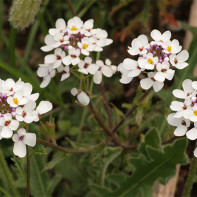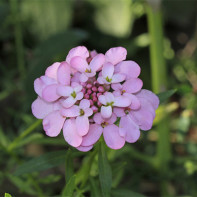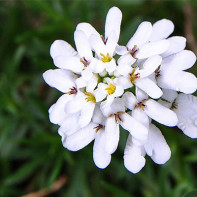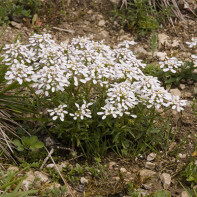Iberia: medicinal properties and contraindications
Iberia is a groundcover herbaceous annual. It belongs to the cruciferous cabbage family, has a large set of beneficial qualities for human health. The plant is poisonous, but when used properly, it can help in the treatment of pathologies of the cardiovascular system, stomach, intestines, as well as the spectrum of infectious, colds and inflammatory diseases.
- Chemical Composition
- What it looks like and where it grows
- Types of
- Harvesting and storage
- Medicinal properties of Iberia
- Iberia bitter in folk medicine
- In cholecystitis and gout
- In open wounds
- In coronary heart disease
- Sciatica and inflammation of the sciatic nerve
- Chronic hepatitis
- Prolonged cholestasis (stagnation of bile in the liver)
- Chronic sore throat inflammations.
- Irritable bowel syndrome
- Kinds of medicinal compositions
- Infusion
- Infusion
- Decoction
- Compress
- Contraindications for use
The medical name of the herbalist is Iberidisherba. In the popular names: "raznopetalnik", "pepper", "village mustard", "stennik.
Chemical Composition
The composition is not fully understood, which limits the use to specific areas. At the same time, the seeds and stem of the plant are endowed with the already known unique structure in its qualities. They contain:
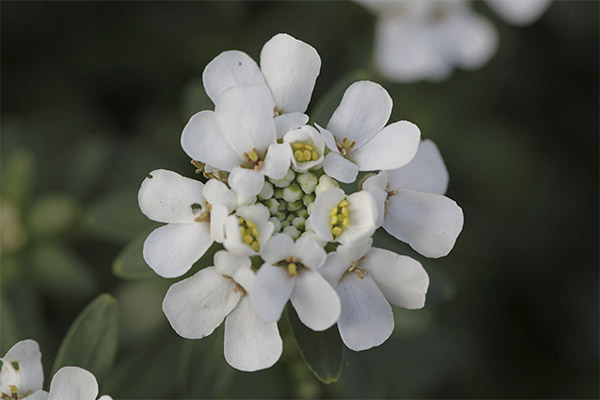
- Cucurbitacin groups E, I, J, K (antitumor, antimicrobial antihelminthic properties).
- Glucoiberin (antioxidant).
- Glucoheiroline (plant antibiotics, antiviral agent).
- Flavonols (regulation of enzyme formation).
- Glucosinolates (amino acids).
The main active components of raznolestnik are considered bitterness, ester, mustard oil glycoside, cucurbitacin and other substances. This list is the basis for the formation of the chemical composition.
Please note: the plant contains poisonous substances. Therefore, the use without consulting a doctor and prescribing a strict dosage can bring severe irreversible consequences for the body.
What it looks like and where it grows
An annual with a bare, rough, ribbed stem reaches an average size of 35-40 cm. The bush itself can grow more than half a meter. The base is densely branched, the leaves are characteristic dark green, pinnately wedge-shaped, elongated. The plant has small white petals up to 2 cm in diameter, gathered in large tassels, purple or pink. The pepper is always four-petaled, the edges are characteristically oblong.
The flowering period of the Variegated Pepper is limited to the summer months (June to August), after which it bears fruit. Depending on the weather conditions, it may re-bloom. The optimum temperature is around 18-20°C. Until the end of September you will find bivalve-shaped, round, flattened capsules with brown (or in some cases yellow or red) seeds inside which to propagate.
The original place of origin is thought to be Spain (formerly called Iberia).
Additional information: The Roman erudite writer Pliny the Elder, while in Iberia, is said to have cured his friend of gastrointestinal pains with the help of the mullein. Therefore, the name of the herb and its origin are tied to this place.
This species is heat-loving and heat-tolerant, so the habitat of Iberia is Central Europe and the Mediterranean. In Russia it can be found in the southern territories (Crimea, Caucasus, Don), sometimes in the European part of the country.
The herb lives mainly in mountainous, rocky areas in loose soil with a high lime content. Requires plenty of sunlight and moderate moisture for abundant growth. The crop has long been domesticated, so its garden cultivation and propagation by cuttings is possible.
Types
Due to its unpretentiousness and appearance, the semi-shrub is often used not only for medicinal purposes, but also in landscape design, which is of great interest to gardeners and breeders. Thanks to them, more than 30 varieties have been bred, some of them are perennials, which means they are resistant to frost and can survive the winter period without consequences. Basically, all subspecies are dissimilar to each other by the shape of the leaves, in some cases differ in the color of the buds. The following varieties are particularly popular:
Iberis evergreen.
A perennial shrub of large stature (30-40 cm). The leaves are oblong, deep dark colored, reach 7 cm in length. The buds of this subspecies are umbrella-shaped, light-colored, up to 5 cm in diameter. Flowering begins in summer and lasts about 20-25 days. The remarkable feature of the species is that the buds almost completely cover the branches during opening. The plant can bloom again in late summer and be fruitful.
Varieties:
- LittleGem - low, lush canes up to 50 cm in diameter. It has large evergreen, glossy leaves. It blooms in April and May, at which time the plant has up to 200 brushes per bed.
- Winter magic (Winterzauber) - recognizable by its extremely early blooming, which begins as early as March.
- Zwerge schneeflocke (Zwerge schneeflocke) - one of the domesticated varieties, unpretentious in care and grows well in stony beds. A small herbaceous variety (up to 15 cm). The color of the ovary is light blue. Remarkable for its long flowering period.
- Findel is a low (20 cm) and wide (up to 1 m) semi-branched, strongly branched at the sides. The flowering period is short.
- Dana is a variety of white-flowered Iberis. Dense flowering, not taller than 15 cm.
Iberis gibraltaricus.
A Spanish low-growing semi-shrub. It can be found in the south of the country and in Morocco. In spring it blooms in pink tassels, reaching a mark of 25 cm high and 40 cm in diameter. A good arboretum, provided with plenty of sunlight, should be prepared for cultivation. Occurs in Russia. The most common are:
- Gibraltar wallflower (Gibralter Candytuft) is a low herbaceous plant (size varies from 15 to 35 cm). When blooming it is covered with a dense cap of inflorescences from white to deep lilac shade. Heat-loving, requires a well-warmed place and non-acidic soil.
- Candy Tuff is one of the largest varieties of Gibraltar Variety. The size of the inflorescences is close to dahlias. Rare, so valued by breeders. Requires drained soils with little moisture to grow.
Both varieties are distinguished by their delicate purple inflorescences, eventually taking on a pure white color.
Iberis krymica
Named so because of the place of origin - first found in the Crimea. Perennial rises from 5 to 10 cm. Greyish color, non-bright stems are lowered down. The buds are characteristically purple, later gaining a white color.
Dry, properly fertilized soil with calcium and a sunny space is desirable for cultivation.
Iberis rocky.
Resembles a cumulus cloud or snow cap because of the abundance of tassels and coloration. It is a low (10-15 cm), evergreen, temperature tolerant species. Can be found in Europe from the Iberian Peninsula to southern Russia. Most common are:
- Pygmaea (Pygmaea) - canopy (maximum 10 cm tall) lying in broad array, elongated, needle-shaped leaves, heads small and light colored.
- Weiss Riesen (Weiss Riesen) is a variety of rock variegated. Large bush (reaches 30 cm) with white flowers.
- Hyacinthenblutige Riesen (Getitemviewtype Riesen) - about 35 cm long. The bright lilac bunches stand out beautifully against the dark shoots.
Note: Replanting rocky stonecrop is undesirable, as the tap root system is easily injured.
Iberis bitterbush.
Reaches an average height of 30 cm. Scalloped, toothed branches are downward. The stem is spaciously branched from the root. Fragrant small flowers, white or purple, 1.5 to 3 cm in size. Subspecies:
- Iceberg (Eisberg) - tall (40-45 cm) with large toothed leaves. The buds are elongated (tassel-shaped) and light in color.
- Empress - shaped like a candelabra, reaches a height of 30 cm. The leaves are long and toothed. Externally, the flower looks like a hyacinth.
Iberis umbrella
This annual is found in southern Europe. It has tall (up to 40 cm), smooth stems and dense, white inflorescences (can sometimes be purple). The leaves are large and shiny, with an emerald hue. Has dense white inflorescences (can sometimes be purple). Starts blooming after 2.5 months from the day of planting. Seeds are yellow or red. Subspecies:
- Miracle Mix (Fairy Mix) - small (15-20 cm), obtained from a collection of different seeds, which makes the petals take on unpredictable colors.
- Red Rush is about 30 cm tall, with long green twigs. The species is distinguished by its atypical coral-red coloring of the buds.
Gathering and storage
The blooming period of the stannik is the time for harvesting raw materials. Weed should be cut in the required amount, then view for rotten leaves, stems and unnecessary debris. Then proceed to the drying of the resulting mass. For complete drying, it should be sliced and laid in a dry place with a cloth to 2-3 cm thick (to ensure adequate ventilation). This will avoid dampness and rotting of the collection. After that, be sure to turn the herbs daily and monitor their condition.
Store dried herbs in special paper bags or gauze bags, this is necessary for proper air circulation. This form of storage allows you to use it for two years. At the end of this period, the useful components cease to have a therapeutic effect.
Seeds should also be harvested. This should be done between August and September. The process is not much different from the actions described above: you need to put the seeds on a tray in a well ventilated place until they are completely dry and after the procedure is finished, place them in paper bags. Shelf life is 24 months.
Important! Do not place the cloth in direct sunlight, as dried seed can burn. To comply with this rule, you can use a shed or other covered space.
Therapeutic properties of Iberia
The range of indications for the use of preparations or independent preparations is quite wide. Many different medicines are created on its basis, aimed at use in cardiology, gastroenterology and homeopathy.
The structure of Iberia is investigated for additional useful properties. A 2014 Comcon Healthindex study found that an extract made from fresh leaves can fully regulate the gastrointestinal tract, keeping it active and healthy. In addition, with the help of such a composition it is possible to overcome common problems: heartburn, bloating, acute pain in the stomach.
In 2004 it was found that sennik bitter is able to adjust to the human body. This is due to the selective regulation of the intestinal muscles depending on the ailment: in the case of a relaxed state - to have a tonic effect, in the case of spasms - relaxing.
Since the 1960s the plant has been used to make various pharmaceuticals in Germany and Belgium. Entire plantations in Dormstadt have been set aside for cultivation. It is the main ingredient for the drug Iberogast ("Ibero" for "Iberian" and "gast" for "stomach") by the German company Bayer.
Additional information: according to statistics, Iberogast was the best-selling gastroenterology drug in Germany in 2013. It is also exported to Russia and other countries, so around the world more than 25 million people have already tried the use of prokinetics.
Other pharmacological preparations and herbal pharmacy compilations are also made from the herbalist.
As mentioned earlier, the beneficial substances contained in the herb have a positive effect on the body. Its unique components help maintain the tone of the cardiovascular system, have a cytostatic and bacteriostatic effect, increase the efficiency of the smooth muscles of the gastrointestinal tract. In addition, they are used to help the elimination of bile and urine.
Therefore, the main list of pathologies in which the use of the following is shown:
- Heart and vascular disease (angina pectoris, tachycardia, oxygen deprivation);
- Functional dyspepsia (gastritis, stomach cramps);
- Ulcers in the stomach and duodenum;
- reduced appetite, nausea, heartburn, flatulence;
- Disorders of the small or large intestine;
- bile secretion problems.
Among other things, the substances contained in the annual have antiseptic, antimicrobial and anti-inflammatory effects, so it is possible to use for symptom relief and treatment:
- Acute bronchitis, pneumonia, sore throat, tonsillitis and other bacterial cold infections.
- Cystitis, urethritis, pyelonephritis and other inflammatory processes in the genitourinary system.
- Skin injuries (disinfecting and healing wounds).
Traditional medicine claims that remedies based on this plant help in the fight against cancer and benign tumors, because they have a cytostatic effect.
Iberian bitter in folk medicine
Pharmaceutical properties are concentrated in the whole ground part of Iberia and its seeds, so look for material for a home medicine cabinet here. From the ground part of the plantation can be made decoctions, infusions, compresses, tinctures for home use. The root system in this case is not involved.
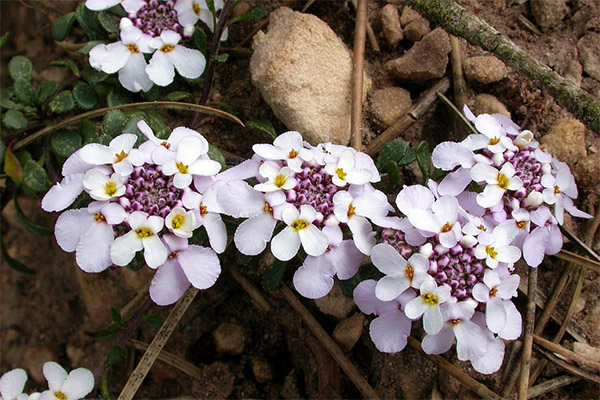
Dried flowers are prepared from July to September, after which they can be used to make products for consumption. They can be mixed with other components. At home, given the peculiarities of the disease, you can prepare medicines according to the following recipes.
For cholecystitis and gout.
A teaspoon of dried herbs pour 400 ml of boiled water, then insist for at least an hour. Use the strained liquid by a tablespoon 5 times a day for 2 weeks. This method can be used for the prevention of chronic diseases every six months.
For open wounds
If the wound does not heal well or does not tighten at all, festering, brings discomfort, you can use the infusion of Iberia. In this case, it is impossible to overdose, so there are no contraindications to use.
2 teaspoons of the herb pour 150 ml of hot water, infuse for an hour. Gauze soaked in a strained infusion and apply to an open wound for 30 minutes twice a day. Repeat daily until completely healed.
When coronary heart disease.
To prepare you will need 20 grams of seeds. Pour them with vodka at the rate of 150 ml of liquid for each 20 grams. Insist the mixture for 20 days. The resulting solution to use in the form of drops (10 drops per glass) 3 times a day, an hour after meals.
In sciatica and sciatic nerve inflammation
Mix a teaspoon of dried flowers with a spoonful of seeds, then pour 300 ml of water at room temperature for 2 hours. After that, bring the remedy to a boil (but do not boil) and insist another 2 hours. Consume the decoction by a tablespoon three times a day until the elimination of symptoms.
With chronic hepatitis.
Infuse a mixture of dried herbs in vodka in the proportion 1:10 in the dark for 30 days. Drink with water, adding 5 drops per glass, until relief of symptoms. The same method is acceptable for pathologies of the nervous system, gallbladder disorders, lack of appetite.
With prolonged cholestasis (bile stagnation in the liver)
For productive treatment, use herbal gatherings, which include Iberia (2 parts). In addition, such gatherings may include chamomile flowers (1 part), licorice root, celandine, melissa or mint. Therapeutic collection brewed with a glass of boiling water and insist at least 4 hours. Take 2 tablespoons three times a day (14 days). Such pharmacy gatherings can be purchased in ready-made form in the form of tea.
With chronic sore throat
Pharyngitis and chronic laryngitis can be treated with the seeds of the plant. Boil a teaspoon of seeds in 250 ml of water in a steam bath for 5 minutes. Cooled decoction to take 20 ml twice a day (20 days).
With irritable bowel syndrome.
You can relieve irritation of the intestines with a collection that includes an extract of sennik bitter, angelica root, chamomile flowers, cumin, milk thistle fruits and mint. A mixture of 50 grams pour 1 liter of vodka and insist a month. The solution to use 20 drops three times a day to get rid of symptoms of gastrointestinal irritation and spastic colitis.
Types of medicinal compositions
Despite all the benefits that culture gives, even the most experienced herbalists strongly recommend the use of Iberia with caution and only after the recommendation of a specialist. The herb is very toxic, which cannot but pose a danger. The most common recipes involve making infusions, tinctures, decoctions and compresses.
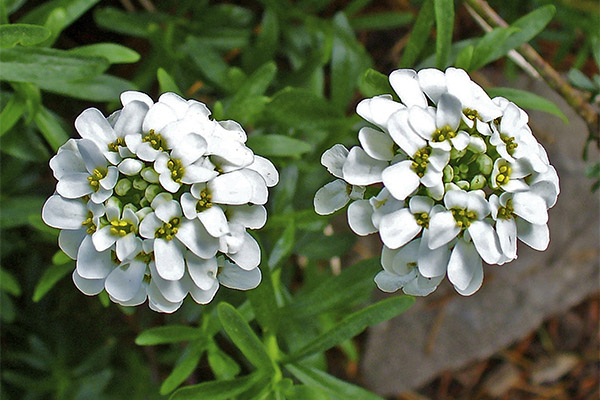
Infusion
Infusions are usually used to treat and relieve the effects of respiratory diseases, hepatitis of various groups, gout, cholecystitis, colpitis and other infections.
The liquid with dried flowers in the necessary proportions (depending on the manifestations of the ailment) is to be insisted in boiled water, strained and further consumed in the established daily rates.
Tincture .
To prepare the tincture should use dried mixture of herbs and vodka. After soaking for 3 weeks, use the liquid in the form of drops. This method helps in the treatment and prevention of pathologies of the blood vessels, heart, nervous disorders and hepatitis. The number of drops per glass of liquid depends on the specific disease and is given above.
Decoction
Decoctions in small doses are useful in various diseases. They are taken in cases of impaired bile secretion, appetite disorders, gastrointestinal tract. Plus, Iberia is often used in homeopathy in conjunction with other herbs.
Compress
The compress has a positive effect on tissue regeneration and healing of open unhealed wounds, pustules, burns, has an antiseptic effect. They are applied by wetting a clean gauze bandage with periodic application to the affected area.
Contraindications to use
Because of its toxicity, extracts and preparations containing Iberia are among the most dangerous. An overdose if used improperly can cause irreparable harm to health, as well as lead to asystole (cardiac arrest) and death. Therefore, uncontrolled treatment with drugs and self-preparation is strictly prohibited.
In addition, a number of specific contraindications to internal administration is enshrined:
- Pregnancy and the period of breastfeeding;
- Children under 16 years of age (due to lack of clinical data);
- acute pancreatitis;
- abnormalities of the urinary system;
- Large stones in the kidneys and bile ducts;
- Individual intolerance to the components;
- Allergic reactions of the body (including hypersensitivity).
For analysis of the clinical picture and the appointment of a specific drug therapy, it is necessary to consult a doctor.
«Important: All information on this site is provided for informational purposes only purposes. Before applying any recommendations, please consult with a specialized specialist. Neither the editors nor the authors are liable for any possible harm caused by materials."

